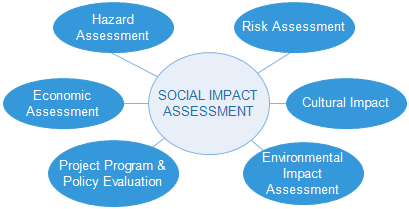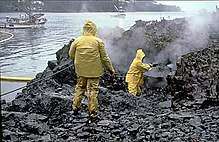Social impact assessment
Social impact assessment (SIA) is a methodology to review the social effects of infrastructure projects and other development interventions. Although SIA is usually applied to planned interventions, the same techniques can be used to evaluate the social impact of unplanned events, for example disasters, demographic change and epidemics.
Definition

The origins of SIA largely derive from the environmental impact assessment (EIA) model, which first emerged in the 1970s in the U.S, as a way to assess the impacts on society of certain development schemes and projects before they go ahead - for example, new roads, industrial facilities, mines, dams, ports, airports, and other infrastructure projects. In the United States under the National Environmental Policy Act, social impact assessments are federally mandated and performed in conjunction with environmental impact assessments.[1] SIA has been incorporated into the formal planning and approval processes in several countries, in order to categorize and assess how major developments may affect populations, groups, and settlements. Though the social impact assessment has long been considered subordinate to the environmental impact assessment, new models, such as the Environmental Social Impact Assessment (ESIA), take a more integrated approach where equal weight is given to both the social and environmental impact assessments.[2]
Contents
Definitions for "social impact assessment" vary by different sectors and applications. According to the International Association for Impact Assessment, "Social impact assessment includes the processes of analyzing, monitoring and managing the intended and unintended social consequences, both positive and negative, of planned interventions (policies, programs, plans, projects) and any social change processes invoked by those interventions. Its primary purpose is to bring about a more sustainable and equitable biophysical and human environment."
SIAs originate from the 1970s and were originally used in Anglo-Saxon environments with indigenous peoples, like the United States, Canada and Australia. Use of SIA's, in general in combination with Environmental Impact Assessments (ESIA) has since then developed, and are legally required in many other countries, ranging from development countries like Sierra Leone and Chad, emerging markets like Chile and Philippines but also other OECD countries like Greenland and South Africa.
Increased pressure on available land and increasingly educated and competent local communities can lead to high costs for public acceptance of complex projects with adverse risks and effects. SIAs are increasingly seen as an effective instrument to bring these costs down by determining views of affected communities on risks, effects and mitigation measures based on a sound socio-economic baseline study.
The IFC Performance Standards are generally seen as the benchmark for ESIAs and insert this in an overarching Environmental and Social Risk Management System, which is based on proven risk management techniques. The IFC Performance Standard is used by multinational companies and commercial investors. Commercial banks have united themselves under the Equator Principles with over 90 members in 37 countries.
SIA overlaps with monitoring and evaluation (M&E). Evaluation is particularly important in the areas of:
- public policy,
- health and education initiatives, and
- international development projects more generally, whether conducted by governments, international donors, or NGOs.
In all these sectors, there is a case for conducting SIA and evaluations at different stages.
The Hydropower Sustainability Assessment Protocol is a sector specific method for checking the quality of environmental and social assessments and management plans.
Non-experts and local people should participate in the design and implementation of proposed developments or programmes. For example, in the field of research projects, it can be identified what people using social media platforms say and share about the social impact of science.[3] This can be achieved in the process of doing an SIA, through adopting a participatory and democratic research process. Some SIAs go further than this, to adopt an advocacy role. For example, several SIAs carried out in Queensland, Australia, have been conducted by consultants working for local Aboriginal communities who oppose new mining projects on ancestral land. A rigorous SIA report, showing real consequences of the projects and suggesting ways to mitigate these impacts, gives credibility and provides evidence to take these campaigns to the planning officers or to the courts.
See also
- B Corporation
- Economic impact analysis
- Life Cycle Thinking
- Social return on investment
- Stakeholder analysis
- Systems thinking
- Social earnings ratio
References
- Tilt, Bryan; Braun, Yvonne; He, Daming (2009). "Social impacts of large dam projects: A comparison of international case studies and implications for best practice". Journal of Environmental Management. 90: S249-57. doi:10.1016/j.jenvman.2008.07.030. PMID 19008036.
- Dendena, Bianca; Corsi, Stefano (2015). "The Environmental and Social Impact Assessment: a further step towards an integrated assessment process". Journal of Cleaner Production. 108: 965–66. doi:10.1016/j.jclepro.2015.07.110.
- Pulido, Cristina M.; Redondo-Sama, Gisela; Sordé-Martí, Teresa; Flecha, Ramon (2018-08-29). "Social impact in social media: A new method to evaluate the social impact of research". PLOS One. 13 (8): e0203117. doi:10.1371/journal.pone.0203117. ISSN 1932-6203. PMC 6114920. PMID 30157262.
Further reading
- A listing of the key citations in social impact assessment, prepared by the International Association for Impact Assessment.
- Barrow, C.J. 2000. Social Impact Assessment: An Introduction. London: Arnold.
- Becker, H and F Vanclay. 2003. The International Handbook of Social Impact Assessment. Cheltenham: Edward Elgar.
- Becker, H.A., 1997. Social Impact Assessment: Method and Experience in Europe, North America and the developing world. London: UCL Press
- Burdge, Rabel J. 2004. The concepts, process and methods of SIA. Middleton, WI: The Social Ecology Press. ISBN 0-941042-35-9.
- Burdge, Rabel J. 2004. A Community Guide to Social Impact Assessment. Middleton, WI: The Social Ecology Press ISBN 0-941042-17-0.
- Dufour, Bryan 2015. State of the art in social impact measurement: methods for work integration social enterprises measuring their impact in a public context, 5th EMES Conference
- Franks, Daniel M. 2011. Management of the Social Impacts of Mining. In Peter Darling (Ed.), SME Mining Engineering Handbook Third ed. Chapter 17.4, pp. 1817–1825. Littleton, Colorado, USA: Society for Mining, Metallurgy, and Exploration.
- Franks, Daniel, Fidler, Courtney, Brereton, David, Vanclay, Frank and Clark, Phil (2009) Leading practice strategies for addressing the social impacts of resource developments Brisbane, Australia: Centre for Social Responsibility in Mining, Sustainable Minerals Institute, The University of Queensland & Department of Employment, Economic Development and Innovation, Queensland Government.
- Franks, Daniel M 2012. Social impact assessment of resource projects. Mining for Development: Guide to Australian Practice, International Mining for Development Centre, Australian Government, University of Queensland and University of Western Australia.
- Franks, D.M. and F Vanclay 2013. Social Impact Management Plans: Innovation in corporate and public policy, Environmental Impact Assessment Review, 43, 40–48.
- Hanna, P. & Vanclay, F. 2013. Human rights, Indigenous peoples and the concept of Free, Prior and Informed Consent, Impact Assessment & Project Appraisal, 31(2), 146-157.
- Howitt, Richard 2003. Local and non-specialist participation in impact assessment, in: C.-Q. Liu, Z. Zhao, T. Xiao and J. Guha, Strategic Management of Environmental and Socio-Economic Issues: A Handbook. Guiyang, China, Guizhou Science and Technology Publishing House, 27-36
- Howitt, R. 2001. Rethinking resource management: justice, sustainability and indigenous peoples. London: Routledge.
- Kemp, D. & Vanclay, F. 2013. Human rights and impact assessment: clarifying the connections in practice, Impact Assessment & Project Appraisal 31(2), 86-96.
- Terminski, B. 2015. Development-Induced Displacement and Resettlement: Causes, Consequences and Socio-Legal Context, New York, Columbia University Press.
- Kirkpatrick, C. and Lee, N., Editors, 1997. Sustainable development in a developing world: Integrating socioeconomic appraisal and environmental assessment. Cheltenham: Edward Elgar.
- Mayoux, L & R. Chambers 2005 Reversing the paradigm: quantification, participatory methods and pro-poor impact assessment. Journal of International Development 17(2) 271-298.
- Roche, C. 1999. Impact assessment for development agencies. Learning to value change. Oxford: Oxfam
- Taylor CN, Bryan CH, Goodrich CG. 2004. Social Assessment: theory, process and techniques. Middleton, WI: The Social Ecology Press ISBN 0-941042-37-5.
- Vanclay, F. 1999, ‘Social impact assessment’, in J. Petts (ed.) Handbook of Environmental Impact Assessment (Vol 1), Oxford: Blackwell Science, pp. 301–26.
- Vanclay, F. 2002a, ‘Conceptualising social impacts’, Environmental Impact Assessment Review, 22(3), 183–211.
- Vanclay, F. 2002b, ‘Social impact assessment’, in M. Tolba (ed.) Responding to Global Environmental Change, Chichester: Wiley, pp. 387–93.
- Vanclay, F. 2003, ‘International principles for social impact assessment’, Impact Assessment and Project Appraisal, 21(1), 5–11.
- Vanclay, F. 2006, ‘Principles for social impact assessment: a critical comparison between the international and US documents’, Environmental Impact Assessment Review, 26 (1), 3–14.
- Vanclay, F. 2014. Developments in Social Impact Assessment. Cheltenham: Edward Elgar.
- Vanclay, F. & Esteves A.M. 2011. New Directions in Social Impact Assessment. Cheltenham: Edward Elgar.
- Wong, Cecilia H.M.; Ho, Wing-Chung (2015). "Roles of social impact assessment practitioners". Environmental Impact Assessment Review. 50: 124–133. doi:10.1016/j.eiar.2014.09.008.
- Federal Department of Town and Country Planning, Peninsular Malaysia 2012,'Manual for Social Impact Assessment Manual of Project Developmentt', ISBN 978-983-2839-43-9
External links
- Belgian EU Presidency Summary on Social Impact Assessment
- Website of the SIAhub, a sharing platform for SIA practitioners
- The Social Performance practitioners platform, a community of practice for social performance practitioners working in the extractive industries
- International Principles for Social Impact Assessment
- US Principles and Guidelines for Social Impact Assessment
- International Association for Impact Assessment Wiki - SIA page
- Using Stakeholder Network Analysis in Social Impact Assessment
- Malaysian Association of Social Impact Assessment (MSIA)
- Kakadu Region Social Impact Study (Australia)
